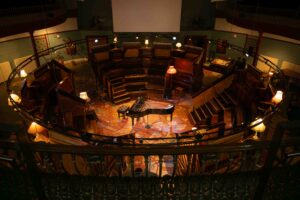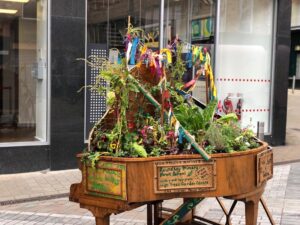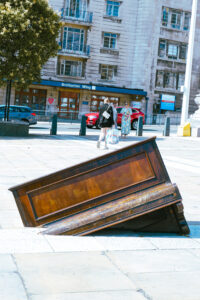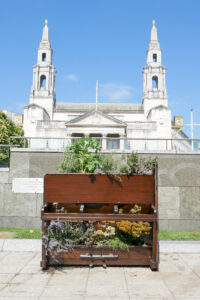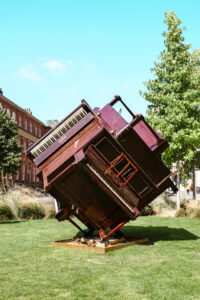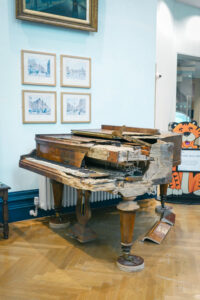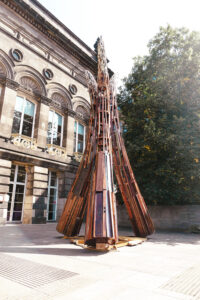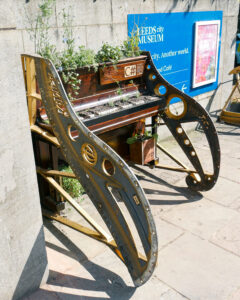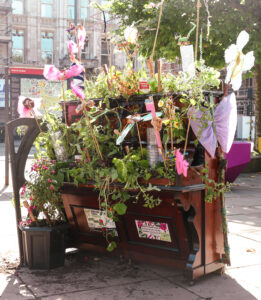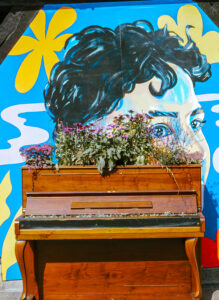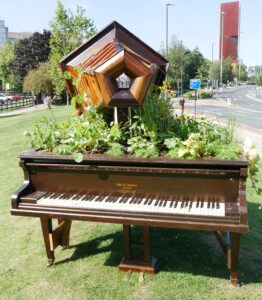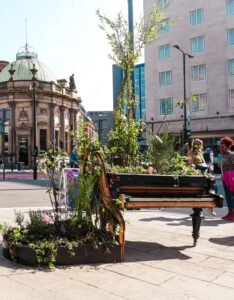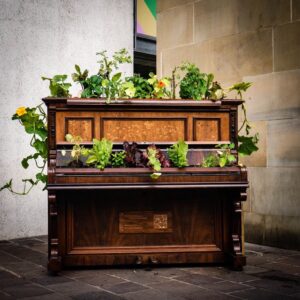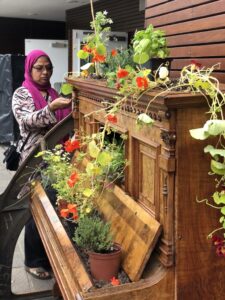Piano Trail Festival – Piano Sculptures & Planters
The Pianodrome
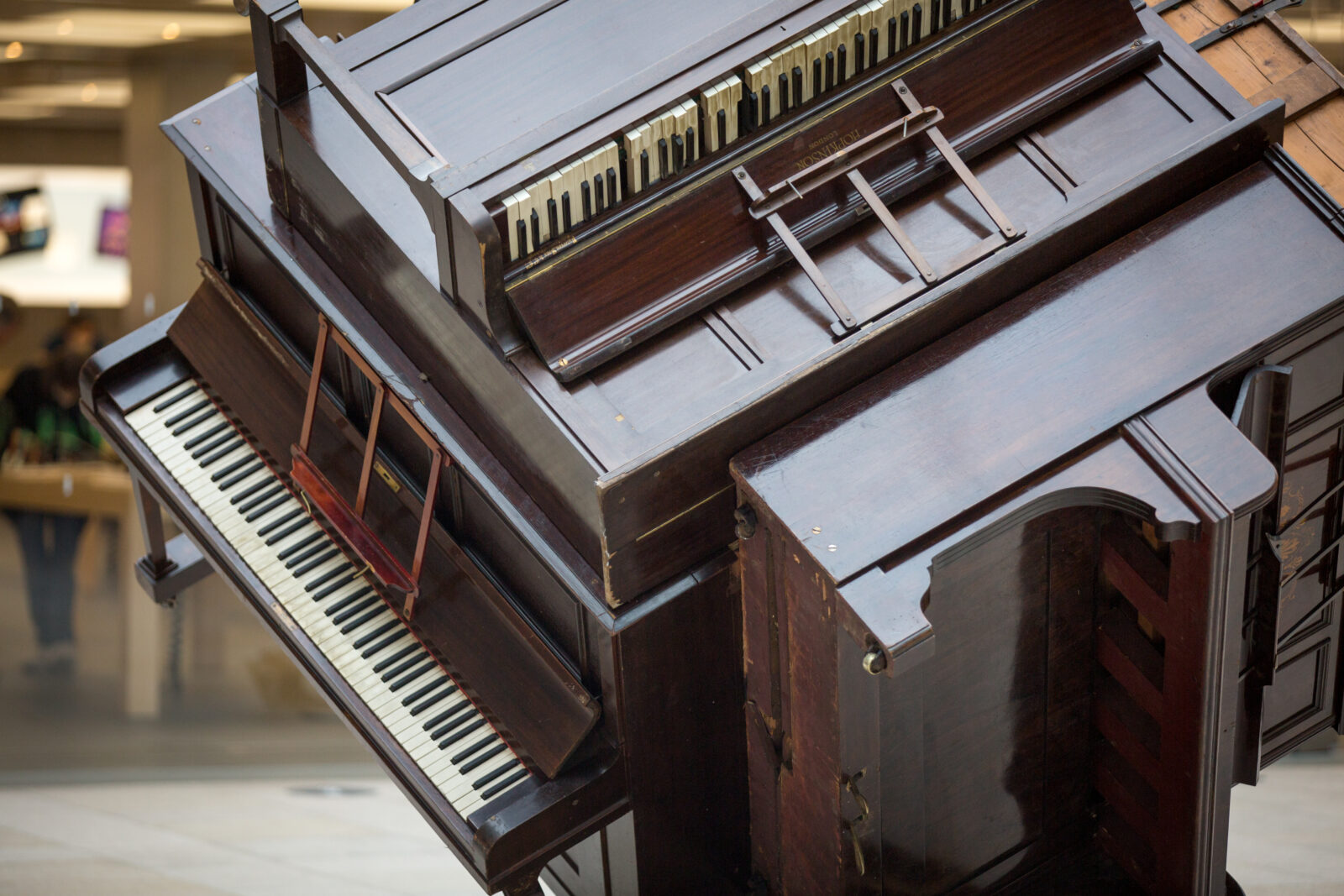
Welcome to the Leeds Piano Trail Festival!
As well as our usual trail of decorated pianos in public spaces across Leeds, Pianodrome, our ‘Artists in Resonance’ at the Leeds International Piano Competition, have made a whole new trail of sculptures and planters entirely out of old pianos intercepted on their way to landfill. These amazing ‘piano pieces’ dotted across twelve locations throughout public places in Leeds city centre form a treasure trail which will only be here for three weeks. At the centre of it all in the Brodrick Hall at the Leeds City Museum is the spectacular Pianodrome Amphitheatre. Don’t miss it! Head straight to the museum for your free treasure map. Find the names of the twelve semitone notes written on the sculptures and planters, one at each location and return to the Pianodrome at the Museum to collect your souvenir prize made from a piano part. Some of the sculptures and planters are playable, some are edible, one is moving. All are designed and built by the Pianodrome team and beautifully finished and planted by local community groups with the support of the Royal Botanic Gardens, Kew.
What are you waiting for?
Sculpture Locations
The Pianodrome is a 100 seater amphitheatre made entirely, down to the flathead screws, from pianos that have been intercepted on their way to landfill and repurposed as banks of tiered seating, staircases, balustrades and balconies. Three playable pianos tuned and free for all to play are embedded into three ‘wedges’ of tiered seating which form the circular structure which is resonant in many ways with the surrounding architecture.
Three new public pianos, tuned to resonate in harmony, have been embedded into the three Pianodrome ‘wedges’ of tiered seating specially for the festival each with a different sized keyboard to suit different sized hands, small, medium and large. With LIPC’ media partners Medici TV we hope to make as much of the competition available in a relaxed atmosphere and free of charge via live streamed projections and high quality sound.
While the Pianodrome is in the first place an interactive sculpture free to be played on, in and around by all who follow the piano trail to its centre here, it also serves as a spectacular venue playing host to daily lunchtime concerts, workshops, special events and, with a Steinway concert grand provided by The Leeds, hopefully some extraordinary piano talent from the competition and beyond. The pindrop acoustics, hundreds of hidden resonant strings and intimate in-the-round architecture make Pianodrome a truly unique place to experience all kinds of events whether you are a seasoned concert goer or have never before tried a piano in real life.
Picture credit: Charlie Swinbourne
This beautiful grand planter was made by and for kids. It is filled with lots of colourful flowers signposted with hand painted signs on pieces of piano wood. Dora who runs the project is all about reusing everything. She is even going to run a workshop in the Pianodrome making thumb pianos using piano parts.
“If you are in a shipwreck and all the boats are gone, a piano top buoyant enough to keep you afloat that comes along makes a fortuitous life preserver. In accepting yesterday’s fortuitous contrivings as constituting the only means for solving a given problem we are clinging to a great many piano tops.”
Carved quotation from R. Buckminster Fuller; Operating Manual for Spaceship Earth
If you take a piece of wood, any piece of wood – in this case of from a piano – hold it near one end and strike the middle it makes a ringing sound. If you cut the piece of wood shorter the pitch of the note goes up. Surprisingly then if you carve wood from the middle of the piece, even though you are removing mass, the pitch goes down. This is because you are making the middle less stiff so it vibrates more slowly. It also makes a difference what you hit it with. Piano hammers are great. Also sticks wrapped in felt. Music and nature are all around us if we just open our eyes and ears.
This sculpture is a garden shed, with a playable piano inside, made entirely out of pianos. It’s like climbing inside a piano. If you were lucky enough to have a piano at home when you were young this is probably pretty close to how you first experienced it. The walls are made of piano frames, the roof is made of soundboards and a grand piano soundboard and lid make up the door which hangs on brass grand piano hinges and locks with a piano key. The piano shed was the seed of inspiration from which the garden of beautiful piano planters grew. The stained glass window depicting a gardener amongst the leaves and birds and bees was made specially for the Piano Shed by Hannah Stained Glass. The coloured light gives the earthy Piano Shed a sacred feel.
Even in the smallest spaces grasses and flowers can thrive. As we cover the world in concrete it is worth remembering that it is important to make homes not just for humans. This grand planter was planted by mix of staff and students at the university, botanists and ecologists. They plan after the Piano Festival Trail is over to perhaps turn it into a swamp garden or pond.
This sculpture is a cube of six upright pianos, one for each face, tipped up and surprisingly balanced on its point. Did it fall out of the sky? It looks impossible. How could such heavy objects defy gravity? It has to be seen to be believed.
Equally hard to believe is that so many beautiful old pianos are going to the dump. In order to make the Piano Cube our team of makers and volunteers painstakingly unwound the tuning pins holding the hundreds of strings and unbolted and removed the heavy cast iron frames to make the piano cases as light as possible. The cube was then assembled piano by piano on location especially for the Piano Festival Trail.
Most of the pianos we use in our sculptures were first built before we were born – in some cases more than a hundred years before. When we pull them apart we find traces of stories of the people who played them dropped between the keys, a hairclip, a coin, a stamp. Football cards, cigarette cards, a postcard, a letter, folded, torn, lost, forgotten. Pianos contain time. Where this grand piano has been sand-blasted, it looks like time has melted away the veneer and carved out the grain of the softwood beneath revealing rows of big screws like teeth and tiny fragile mechanical parts in the piano action like the bones of birds.
At Pianodrome we draw inspiration from the materials, the craftsmanship, the sounds and the stories that we find in old pianos. As we take them apart we try to let the pianos tell us what they want to be. In the past the white keys of a piano used to be made from ivory. In most cases this came from elephants but sometimes from mammoth tusks dug out of permafrost. So the idea grew to make piano parts into tusk shapes. And grew and grew. Old pianos are just one example of what our society considers to be waste. But look what happens if you pay attention to the materials and, with a little imagination and handy work, see what you can make.
Breathe deeply as you ride to the museum on your bike. Enjoy the fragrant vegetation as you secure your steed to the ornate cast iron piano harp. Fresh air is the gift of plants. Hollybush Project works with adults with learning disabilities who grew and planted the plants as well as making the natty planter boxes for climbing plants to climb the piano string trellises.
If music be the food of love, play on! All the plants the meanwood crew grow are edible and for this project they especially chose ones which look like musical instruments. Tromboccionnos, bulbous vegetable gourds grow like a brass section and even sound like trombones. Nasturtiums like trumpets blow in the wind. Did you know you could eat them? Go on! Try a leaf or a seed or even a peppery flower.
If you take the keys and casing off an upright piano you are left with the cast iron harp bolted through the spruce soundboard onto the solid wooden back frame. With hundreds of resonating strings exposed a new instrument emerges. Multiplied by four. But how to play it? Reach through the bars and pluck a string. Hear how it rings. Clap or shout into the Resonance Room and hear how the hundreds of strings take up the sounds and reverberate. Listen closely and you can hear all the sounds of the city caught and resonating.
Noise is found all around us. The sound of traffic, the hum of an air conditioner, and the rustling of leaves in the wind are all examples of noise that we hear around us in our environment all day. Each different type of noise has a unique spectral distribution or ‘colour’. This is how the colours of the flowers in the ‘colours of noise’ planter were chosen. Can you imagine what these colours would sound like?
This was originally conceived for Millenium Square on the ‘21 Piano Trail. Two grand pianos sparring across a public space traditionally associated with gatherings and political protest. In the Rose Bowl with one of the playable grands planted by over 60’s volunteers as a medicinal herb garden it speaks to a different kind of empowerment. The soft power of age and experience and the power of plants and music to heal our bodies and our souls. The horns point towards each other as a send and receive pair. You may even find that despite the noise of the traffic your voice is powerful enough to travel across.
What’s that antique piano doing there in City Square with trees growing out of it? This is a great example of circular economy – using the wood of an old piano to make a planter to grow new trees. Bedford Fields is an open access community garden supporting a diversity of volunteers and so their planter with its diverse layers of forestation is wholly appropriate. Different plants will naturally find space to thrive in a forest and maybe there is a useful lesson there for people.
“I like to ride my bicycle, I like to ride my bike. I like to ride my bicycle, I like to ride it where I like.”
Queen
See if you can catch our Piano Bike – a specially built, real playable piano on a bike somewhere in Leeds city centre.
Veg on the Edge grow edible plants and flowers in nooks and crannies all around Saltaire, adding a community vegetable basket, herb garden and orchard to Titus Salt’s World Heritage Site. Their beautiful planter on the edge of Bradford’s City Park contains edible lupins, squash, petunias, tomatoes and nasturtiums and will be lovingly cared for by our friends at Bradford 2025, as they prepare for the city’s much-anticipated Year of Culture. We at Leeds International Piano Competition are delighted to celebrate holding our 2024 Finals in Bradford’s beautiful St George’s Hall on 20th and 21st September, engaging with new communities in Bradford and celebrating Bradford’s richly diverse cultural landscape.
Picture credit: Anthony Recelo
The Women’s Allotment was established on Scotchman Road in 1998, on a plot that was totally overgrown. Transforming it into the serene, green space it is today has taken an enormous amount of hard work – in their own words, “for years, it was a lot of graft and very few vegetables!” Fast forward to 2024, and you can hear women’s voices and laughter on the allotment every Monday morning. The Allotment Group – who describe themselves as “diverse in age and ethnicity as well as knowledge and skills” – meet to work, talk, share what they have grown and eat together. Their magnificent piano planter contains borage, thyme, lavender, nasturtiums and marigolds and everything growing in it is edible. It has been a privilege to work with the Women’s Allotment Group, and if you are ever lucky enough to be invited to one of their renowned Pick, Cook and Share lunches on the allotment, we strongly advise you to go!
